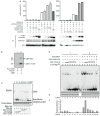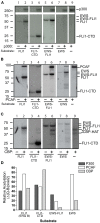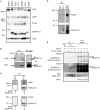Acetylation Increases EWS-FLI1 DNA Binding and Transcriptional Activity
- PMID: 22973553
- PMCID: PMC3435532
- DOI: 10.3389/fonc.2012.00107
Acetylation Increases EWS-FLI1 DNA Binding and Transcriptional Activity
Abstract
Ewing Sarcoma (ES) is associated with a balanced chromosomal translocation that in most cases leads to the expression of the oncogenic fusion protein and transcription factor EWS-FLI1. EWS-FLI1 has been shown to be crucial for ES cell survival and tumor growth. However, its regulation is still enigmatic. To date, no functionally significant post-translational modifications of EWS-FLI1 have been shown. Since ES are sensitive to histone deacetylase inhibitors (HDI), and these inhibitors are advancing in clinical trials, we sought to identify if EWS-FLI1 is directly acetylated. We convincingly show acetylation of the C-terminal FLI1 (FLI1-CTD) domain, which is the DNA binding domain of EWS-FLI1. In vitro acetylation studies showed that acetylated FLI1-CTD has higher DNA binding activity than the non-acetylated protein. Over-expression of PCAF or treatment with HDI increased the transcriptional activity of EWS-FLI1, when co-expressed in Cos7 cells. However, our data that evaluates the acetylation of full-length EWS-FLI1 in ES cells remains unclear, despite creating acetylation specific antibodies to four potential acetylation sites. We conclude that EWS-FLI1 may either gain access to chromatin as a result of histone acetylation or undergo regulation by direct acetylation. These data should be considered when patients are treated with HDAC inhibitors. Further investigation of this phenomenon will reveal if this potential acetylation has an impact on tumor response.
Keywords: EWS-FLI1; Ewing’s sarcoma; PCAF; acetylation.
Figures







Similar articles
-
Impairment of p53 acetylation by EWS-Fli1 chimeric protein in Ewing family tumors.Cancer Lett. 2012 Jul 1;320(1):14-22. doi: 10.1016/j.canlet.2012.01.018. Epub 2012 Jan 20. Cancer Lett. 2012. PMID: 22266186
-
Identification of p21WAF1/CIP1 as a direct target of EWS-Fli1 oncogenic fusion protein.J Biol Chem. 2003 Apr 25;278(17):15105-15. doi: 10.1074/jbc.M211470200. Epub 2003 Jan 30. J Biol Chem. 2003. PMID: 12560328
-
FOXO1 is a direct target of EWS-Fli1 oncogenic fusion protein in Ewing's sarcoma cells.Biochem Biophys Res Commun. 2010 Nov 5;402(1):129-34. doi: 10.1016/j.bbrc.2010.09.129. Epub 2010 Oct 8. Biochem Biophys Res Commun. 2010. PMID: 20933505 Free PMC article.
-
Oncogenic partnerships: EWS-FLI1 protein interactions initiate key pathways of Ewing's sarcoma.Clin Cancer Res. 2010 Aug 15;16(16):4077-83. doi: 10.1158/1078-0432.CCR-09-2261. Epub 2010 Jun 14. Clin Cancer Res. 2010. PMID: 20547696 Free PMC article. Review.
-
EWS-FLI1 in Ewing's sarcoma: real targets and collateral damage.Adv Exp Med Biol. 2006;587:41-52. doi: 10.1007/978-1-4020-5133-3_4. Adv Exp Med Biol. 2006. PMID: 17163154 Review.
Cited by
-
Loss of Stag2 cooperates with EWS-FLI1 to transform murine Mesenchymal stem cells.BMC Cancer. 2020 Jan 2;20(1):3. doi: 10.1186/s12885-019-6465-8. BMC Cancer. 2020. PMID: 31898537 Free PMC article.
-
Structure-function based molecular relationships in Ewing's sarcoma.Biomed Res Int. 2015;2015:798426. doi: 10.1155/2015/798426. Epub 2015 Jan 22. Biomed Res Int. 2015. PMID: 25688366 Free PMC article. Review.
-
Proteomic Analysis of the EWS-Fli-1 Interactome Reveals the Role of the Lysosome in EWS-Fli-1 Turnover.J Proteome Res. 2014 Aug 1;13(8):3783-91. doi: 10.1021/pr500387m. Epub 2014 Jul 14. J Proteome Res. 2014. PMID: 24999758 Free PMC article.
-
Molecular mechanisms of ETS transcription factor-mediated tumorigenesis.Crit Rev Biochem Mol Biol. 2013 Nov-Dec;48(6):522-43. doi: 10.3109/10409238.2013.838202. Epub 2013 Sep 25. Crit Rev Biochem Mol Biol. 2013. PMID: 24066765 Free PMC article. Review.
-
Regulation of EWSR1-FLI1 Function by Post-Transcriptional and Post-Translational Modifications.Cancers (Basel). 2023 Jan 6;15(2):382. doi: 10.3390/cancers15020382. Cancers (Basel). 2023. PMID: 36672331 Free PMC article. Review.
References
-
- Araya N., Hirota K., Shimamoto Y., Miyagishi M., Yoshida E., Ishida J., Kaneko S., Kaneko M., Nakajima T., Fukamizu A. (2003). Cooperative interaction of EWS with CREB-binding protein selectively activates hepatocyte nuclear factor 4-mediated transcription. J. Biol. Chem. 278, 5427–543210.1074/jbc.M210234200 - DOI - PubMed
-
- Bai Y., Srinivasan L., Perkins L., Atchison M. L. (2005). Protein acetylation regulates both PU.1 transactivation and Ig kappa 3′ enhancer activity. J. Immunol. 175, 5160–5169 - PubMed
Grants and funding
LinkOut - more resources
Full Text Sources
Molecular Biology Databases

